Key Plant: Sago Palm (Cycas revoluta)
The sago or king sago palm is an evergreen cycad originally from the tropical islands of southern Japan. It can grow in subtropical areas of the United States, such as Florida, California, Georgia, and Puerto Rico, as well as some moderate climates, such as coastal North and South Carolina. Sago palm is a hardy plant, able to grow in either full sun or partial shade, and can thrive in both outdoor and indoor settings, provided there is sufficient sunlight. Sago palms are slow-growing, reaching heights of up to 15 feet in 50 years. Fronds are 4–5 feet long and up to 9 inches wide. Cycads planted in the shade tend to have larger leaves. Once they become established outdoors, sago palms are hardy enough to be drought resistant but not freeze tolerant. The sago palm is adapted to USDA Hardiness Zones 8–11. In the Florida yard, it can be used with grasses, palms, and many other ornamental plants. Be cautious when planting sago palms in the landscape, however, because all parts of the plant, including the leaves and pith, contain strong neurotoxins that can paralyze or kill animals and humans that ingest them (Northrop et al. 2016).
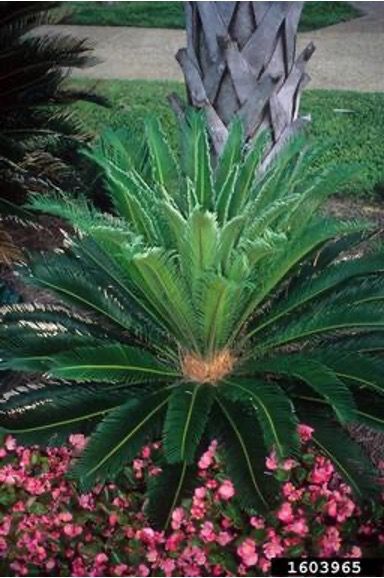
Credit: John Ruter, University of Georgia, Bugwood.org
Key Pests: Sago Palm (Cycas revoluta)
This series of Key Plant, Key Pests publications are designed for Florida gardeners, horticulturalists, and landscape professionals to help identify common pests associated with common Florida flora.
This publication provides information and general management recommendations for aulacaspis scale, other scales, mealybugs, and manganese deficiency. For a more comprehensive guide of woody ornamental insect management, download the current Professional Disease Management Guide for Ornamental Plants or the Integrated Pest Management in the Commercial Ornamental Nursery guide.
Scales
Cycad Aulacaspis Scale (Aulacaspis yasumatsui Takagi)
Recognition: Damage starts as chlorotic blotches on the leaves as the scale insects, covered in a white waxy armor, colonize the undersides of fronds and feed on plant sap. An infestation will cover the plant, including petioles and even roots. Infested leaves become desiccated, turning yellow then brown. Infested new growth becomes deformed, and eventually the whole plant may die. The mature female scale is white, pear-shaped, and approximately 1/16 of an inch long. The male scale is white, rod-shaped, and smaller than the female scale. Newly hatched scales, called crawlers, are yellow, tiny, and mobile. The scale completes its life cycle in about a month, but dead scales stay on the plant for much longer, especially if a white, crusty layer from multiple generations develops.
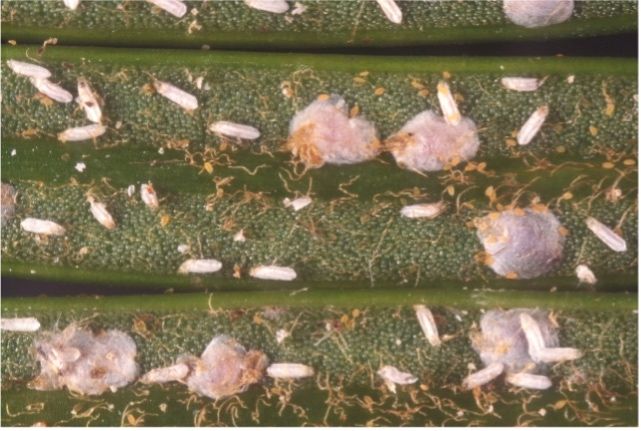
Credit: UF/IFAS
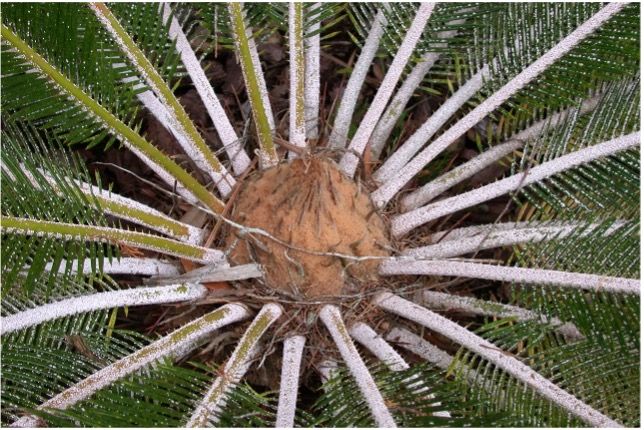
Credit: Lyle Buss, UF/IFAS
Contributing Factors: The scale infests cycads in three different families but has strong preference for the Cycas species. The commonly planted king and queen sagos (Cycas revoluta and Cycas rumphii) are highly susceptible and can be killed by this insect. Infestations seem to be more severe in south and south-central Florida, likely due to the high temperature preference of the insect.
Management Recommendations: Monitor your cycads often, particularly if you are in an infested area. Management is especially difficult because the pest colonizes the roots, providing a protected source of constant reinfestation to apparently clean plants. When scale is observed, wash the plant with a vigorous water spray to clean off both dead and living scales. Mature scales are immobile and cannot move back onto the plant. If plants are heavily infested, remove damaged leaves to reduce the pest population. Take care when disposing of infested plant material so that emerging crawlers are not spread further. In south Florida, two natural enemies of the scale were successfully introduced in the late 1990s: Cybocephalus nipponicus, a tiny predaceous beetle, and Coccobius fulvus, a parasitic wasp. These insects are unable to provide complete control, but they can effectively reduce scale populations at times, especially if broad-spectrum insecticides are avoided. The most consistently effective treatment for homeowners is with oil spray treatments, particularly petroleum-based horticultural oils or fish oil emulsion. To be effective, the sprays must thoroughly cover leaf undersides and other infested plant parts. Roots and crowns of small potted plants can be dipped in a 2% horticultural oil solution to kill scales living there. Commercial landscape pest control professionals will see the best control of this pest with active monitoring and an insecticide rotation program of horticultural oils, insect growth regulators, and systemic insecticides once the pests are detected. For more information, visit Featured Creatures: cycad aulacaspis scale (Weissling, Howard, and Hamon 2020).
Other Scale Insects
Recognition: Over 20 species of scale insects feed on Cycads in Florida. Commonly observed soft scales on sago palm include banana-shaped scale, Prococcus acutissimus (Green), and hemispherical scale, Saissetia coffeae (Walker, 1852).

Credit: False oleander scale—Chazz Hesselein, Alabama Cooperative Extension System, Bugwood.org #5439044. Cycad scale— F. W. Howard, University of Florida, Bugwood.org #5135029 and #5135031. Compiled by Sage Thompson
Management Recommendations: In contrast with cycad aulacaspis scale, infestations of other scales in Florida are less likely to warrant intervention because natural enemies, including predators, parasites, and insect pathogens, will help control populations. Tiny circular holes in the scale coverings indicate parasitic wasps are active and have emerged. Additionally, other scales are not known to colonize the roots. Other control methods include pruning, removing scales by hand, or using the same horticultural oil treatments described above. For more information, visit Featured Creatures: false oleander scale (Hamon and Fasulo 2018) and Managing Scale Insects on Ornamental Plants (Buss and Dale 2016).
Mealybugs
Recognition: Mealybugs are conspicuous insects with waxy secretions covering their bodies. They are mobile and congregate together, giving a cotton-like appearance to foliage. They infest all plant parts and cause growth of unattractive sooty mold, but they prefer newer growth, causing discoloration and/or deformed foliage. Of the 275 species of mealybugs in the United States, the most common species affecting the sago palm is the longtailed mealybug (Pseudococcus longispinus). This is one of several conspicuous mealybugs having long filaments projecting from the rear of the body. For more information on this species, visit Featured Creatures: longtailed mealybug (Byron and Gillett-Kaufman 2016).
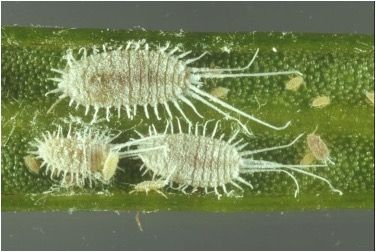
Credit: Lyle Buss, UF/IFAS
Contributing Factors: Longtailed mealybugs are distributed throughout Florida and are one of the most common greenhouse pests around the world. They tend to be most problematic on sago palms growing in shady, cooler areas of the landscape. Mealybugs reproduce and spread rapidly, so immediate control is necessary. Along with several other sap-feeding groups, mealybugs produce a sugary excrement called “honeydew,” which attracts ants that may farm and protect them from would-be predators. Likewise, sooty mold fungus will grow and be associated with mealybug infestations, unlike cycad aulacaspis or false oleander scale infestations.
Management Recommendations: Various ladybeetle species and brown and green lacewings are known predators and can help reduce longtail mealybug numbers. Ideally, allow natural parasites and predators to work by avoiding broad-spectrum insecticides. Chemical controls such as insecticidal soap or horticultural oils should be applied at the crawler stage for maximum efficiency. Other chemical control tools that control the armored scale insects described above are likely to control mealybugs.
Key Abiotic Conditions
Manganese Deficiency
Recognition: The beginning stages of manganese deficiency are yellow and/or brown spots or streaks resembling a pathogenic disease. New fronds develop a pattern comparable to “frizzle top” of true palms, with the young leaves appearing small and distorted and rapidly turning from yellow to brown. Severe cases may have the foliage on the entire top half of the plant distorted and discolored gray and/or brown, or even dead.
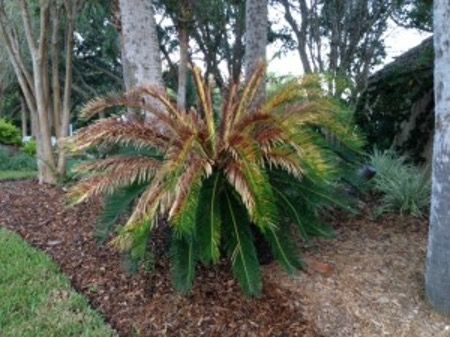
Credit: Mary Derrick, UF/IFAS
Contributing Factors: Insufficient soil manganese or high (alkaline) soil pH that severely limits manganese availability are possible direct causes. However, any problems that restrict root growth and function can prevent the plant from obtaining adequate manganese and other essential nutrients for new growth. Root rot, too much or too little water, poor drainage, and recent transplanting are all factors that may result in manganese deficiency symptoms.
Management Recommendations: Check site conditions for the underlying cause of the problem. Although not true palms, sago palms share similar nutrient requirements, so palm fertilizer products containing manganese are a popular choice. Soil applications of manganese sulfate may help in the short term. Valuable plants may be potted up to try to improve root growth to correct the problem. Spotted leaves will not recover and may be removed after growth of new, healthy fronds occurs.
Cold Injury
Recognition: Sago palms are surprisingly tolerant to brief periods of cold temperatures but will suffer foliar damage when exposed to cold snaps and frost. This can cause great concern and is often mistaken for a disease or other condition. Fronds with cold injury often have sections evenly browned, with most of the damage occurring on upper leaves. Later, an undamaged new flush of growth should emerge.
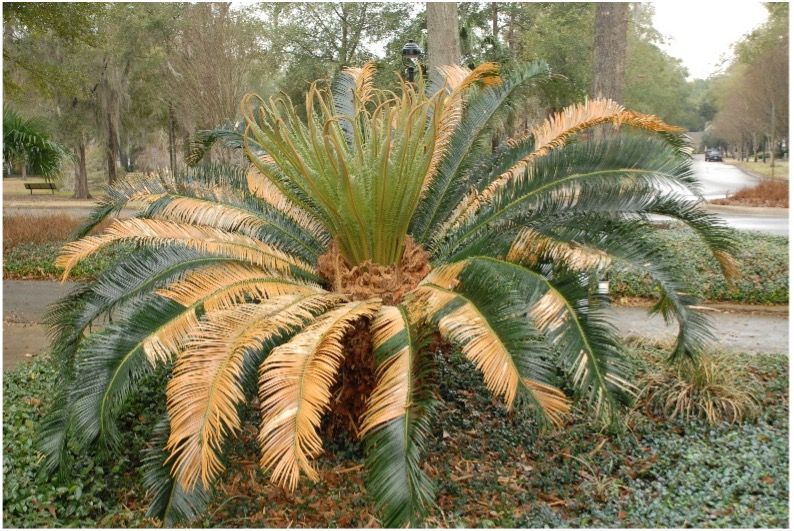
Credit: Lyle Buss, UF/IFAS
Management Recommendations: Do not remove damaged fronds until all danger of frost is passed, because upper leaves may continue to protect lower fronds from damage. Fronds can later be pruned as needed. The plant crown is more resilient to cold, so providing good cultural care to encourage healthy new growth is sufficient.
References
Buss, E. A., and A. G. Dale. 2016. “Managing Scale Insects on Ornamental Plants.” EDIS 2016 (6), 7. https://journals.flvc.org/edis/article/view/127873
Byron, M. A., and J. L. Gillett-Kaufman. 2019. “Longtailed Mealybug, Pseudococcus longispinus (Targioni Tozzetti) (Insecta: Hemiptera: Pseudococcidae).” EDIS 2016 (8), 3. https://journals.flvc.org/edis/article/view/128018
Hamon, Avas B., and Thomas R. Fasulo. 2021. “False Oleander Scale, Pseudaulacaspis cockerelli (Cooley) (Insecta: Homoptera: Coccoidea: Diaspididae).” EDIS 2003 (2). https://edis.ifas.ufl.edu/publication/in306
Mannion, C., A. Hunsberger, K. Gabel, E. Buss, and L. Buss. 2006. “Cycad Aulacaspis Scale, (Aulacaspis yasumatsui).” https://trec.ifas.ufl.edu/mannion/pdfs/CycadScale.pdf
Northrop, R. J., M. G. Andreu, M. H. Friedman, M. McKenzie, and H. V. Quintana. 2019. “Cycas revoluta, Sago Palm.” EDIS 2010 (4). https://journals.flvc.org/edis/article/view/118581
UF/IFAS Gardening Solutions. 2014. “Cycad Aulacaspis Scale.” https://gardeningsolutions.ifas.ufl.edu/care/pests-and-diseases/pests/cycad-aulacapsis-scale/
Weissing, T. J., F. W. Howard, and A. B. Hamon. 2020. “Cycad aulacaspis scale, Aulacaspis yasumatsui Takagi (Insecta: Homoptera: Sternorrhyncha: Diaspididae).” EDIS 2002 (4). https://edis.ifas.ufl.edu/publication/in253